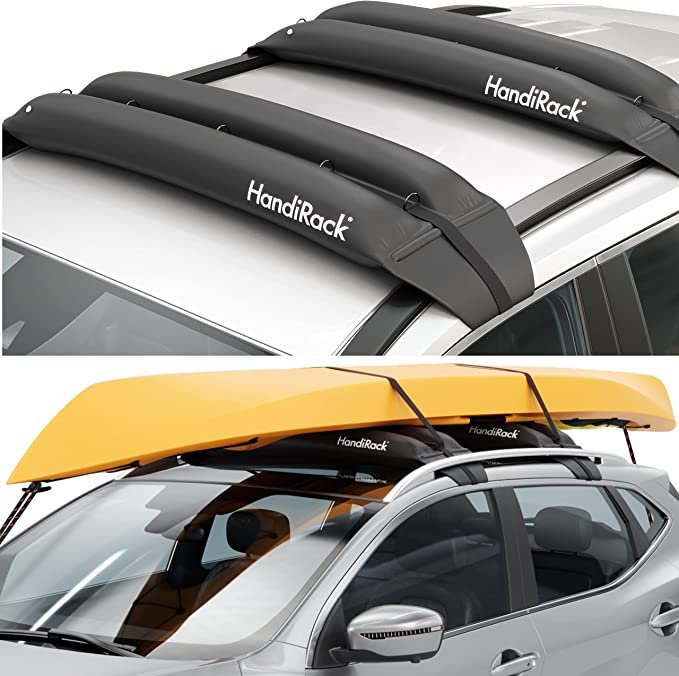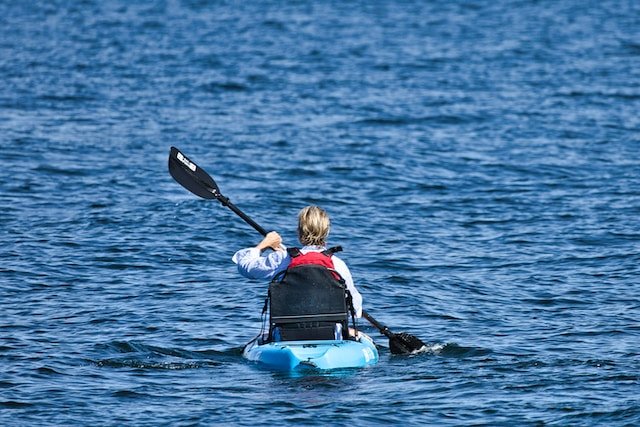How To Roll A Kayak – A Detailed Guide

Kayaking is a popular water sport enjoyed by people of all ages and fitness levels that involves paddling a small, narrow watercraft called a kayak. As with all things though, kayaking is not without its risks one of which is capsizing.
Though kayaks are very stable, they sometimes capsize especially when used in rough water conditions, and getting back into the vessel safely is of utmost importance. A kayaking technique all paddlers should be aware of that solves this problem is rolling a kayak.
The technique involves righting a kayak after a capsizing such that you regain control of the vessel and can continue your kayaking adventure.
This technique is a life-saving skill and as such is one novice paddlers should spend time mastering to ensure their safety on the water.
Over the years, several rolling techniques have been invented to help ensure kayakers’ safety but we will discuss two of them today to help you as a beginner kayaker master rolling a kayak should you need to.
Keep in mind that while this guide will help you start practicing rolling, you can also learn to roll a kayak from someone who has already mastered the skill, and the help of such a person is needed for the exercises to help ensure your safety. Read on and enjoy!
How To Roll In A Kayak
As rolling a kayak is a life-saving skill, practicing to master it can be dangerous so it is recommended to start your training in controlled conditions and increase the difficulty level of the conditions steadily as you progress before ever having to perform the technique in real-time when kayaking on your own.
Part of these controlled conditions is having someone to help you with your exercises. This helper need not be an experienced kayaker as finding one could be difficult; it is sufficient that they are familiar with the process of rolling a kayak so that they will not only serve as a helping hand but will also help correct you should make mistakes in your exercises.
The next thing you need is ideal water conditions to practice rolling a kayak. Your water body of choice should have warm, calm, clear, and waist-deep water to make your rolling practice as safe as possible.
A swimming pool is usually the ideal or perfect training ground for rolling a kayak but if you can’t access one, you should find a water body that fits the required conditions to start your training.
Remember to steadily increase the difficulty level of the conditions around you as you start getting the hang of rolling your kayak because if you have to use this technique in real time, it won’t be in ideal water conditions.
One other thing to remember is that even after getting the hang of rolling your kayak, you should practice from time to time as practice makes perfect and after practicing for some time, rolling your kayak becomes more intuitive than cognitive.
So the more you build your instincts to react in such conditions, the higher your probability of success when you have to roll your kayak even in rough or choppy waters.
Tips To Remember Before Starting Practice
- Choose the ideal location: Your practice site must be one with ideal water conditions for your safety. If you can’t get a swimming pool, make sure the water body you choose fits the bill, and be mindful of the wind and wave conditions while practicing.
- Wear appropriate gear: Your paddle is an essential piece of equipment when rolling your kayak so to completely grasp how it should move when rolling your kayak, you should be fitted with the right gear such as a mask or goggles to aid you in seeing what goes on in the water. Seeing the paddle is part of why the water body you train in should be clear.
- Use a tippy kayak: As stated earlier, kayaks are quite stable so capsizing is rare. Stability varies with kayaks however so to aid in practice, you should start with a tippy or non-stable kayak as the more stable a kayak is, the harder it is to roll. Tippy kayaks often have a low volume so using the kayak with the least volume at your disposal is ideal. Note that while tippy kayaks help make training easier, they are not a prerequisite to learning how to roll, and if you do not have one at hand, you can make do with a more stable kayak.
- Know how to wet exit: This is a prerequisite before learning to roll a kayak. The wet exit is a technique used by kayakers to exit their kayaks in the event of an emergency which is usually a capsizing when the kayaker is unable to right the kayak. The technique involves flipping the kayak over and then releasing yourself from and sliding out of the cockpit. The wet exit should be performed as quickly as possible to avoid being trapped in the overturned kayak. The wet exit can be performed by both solo and tandem kayakers.
Knowing how to wet exit before learning how to roll is important because should things go south, the knowledge of wet exit will help you get out of your kayak safely.
Fundamentals Of Rolling A Kayak
There are two basic principles in rolling a kayak upon which the rolling techniques are built. They are:
Your Head Should Come Out Of The Water Last
For a successful roll of the kayak, your head should be the last part of your body to leave the water. As you are bent with part of your body in the cockpit, your hips should be the first body part to leave the water, followed by your shoulders and finally your head.
Prematurely lifting your head would put pressure on the kayak resulting in it remaining upside down.
Hip Snap
Though it may seem odd, the successful rolling of a kayak depends more on the kayaker’s hips than his paddle. The paddle is essential in providing support but it is your hips that snap the kayak upright completing the roll.
Hip Snap Practice
As you may have guessed, the hip snap is not as simple as it sounds and will take time to master especially since the hip snap should take place before lifting your shoulders and head from the water, while you will naturally want to lift your head first from the water.
Your chosen helper will be essential at this stage as he will play the role of the paddle by giving you support preventing you from getting deeper into the water and getting hurt.
The helper does this by holding your hands and giving you support while you roll the kayak. To help practice this move, a hip snap drill is given below.
Hip Snap Drill
- Your helper is to stand waist-deep in the water of your chosen practice site and hold your hands.
- With the help of the person holding your hands, flip the kayak such that your head is in the water with your face partially submerged. This is done to simulate capsizing in controlled conditions.
- Using your helper for support, try to roll the kayak with your hips or hip snap the kayak such that it is right side up.
- Remember you have nothing to fear as your partner provides support preventing you from drowning, and you are equipped with a mask or goggles to help you see, so focus on hip-snapping the kayak into position.
- If done properly, the kayak snapping right side up will tug you along, and you should make sure you move your body into your kayak seat in the aforementioned order of hips, shoulders, and finally your head.
- Practice until you master it. Practice is crucial because you will notice that the temptation of lifting your head from the water first is often too hard to resist, so practice helps overcome that urge.
Rolling Techniques
Several techniques exist to roll a kayak but the two most famous for beginner kayakers that we will be learning today are:
- The sweep roll or screw roll, and
- The C to C roll.
Before practicing either of these techniques, make sure your helper is nearby to supervise and ensure the training takes place in a safe and controlled environment. Also, don’t forget to gradually increase the difficulty level as you get used to the techniques.
The sweep roll and the C to C roll are beginner-friendly roll techniques and both start the same way which is with your paddle in the optimum position to provide the most support.
In real life after a capsizing, you will have to get the paddle into said position before beginning either roll technique, but as a novice, you should start your practice session with your paddle already positioned so you will quickly get the hang of the techniques.
You are also advised to master the two rolling techniques as they each have moments when they are most ideal to use, and having two aces up your sleeve when it comes to safety is always better than having one.
If you are right-handed, you should start the session with the paddle on your left and if you are left-handed, you should start with the paddle on your right. After mastering rolling the kayak from that side, you can learn to roll the kayak from the other side too.
Getting Into Position
The following tips will help you simulate a capsizing and get into position for either performing the sweep roll or the C to C roll.
- Once seated on your kayak, hold your paddle parallel to your kayak and flat against the surface of the water. Make sure the power face of your paddle blade is facing upwards.
- Next, you tip your kayak over by tucking your head forward and leaning your body towards the paddle. This will unbalance your kayak causing it to tip over.
- After simulating the capsizing by tipping the kayak over, move your head and body towards the water’s surface and far out of the kayak. Make sure you keep the paddle above the water surface while your other forearm should be pressed against the side of the kayak for support.
The Sweep Roll or Screw Roll
The sweep role is the most basic roll technique taught to novice kayakers. This technique is ideal for righting a kayak in open or flat waters and requires a lot of space to perform so it should not be performed if you capsize in a narrow space.
The sweep roll requires less setup than the C to C roll, but here, the paddle provides support to the kayaker for a longer period. The sweep roll also requires more space than the C to C roll to perform.
During practice, you should estimate how much space you need to successfully perform a sweep roll so you will be able to tell if you have enough space for the technique should you capsize in real time.
How To Sweep Roll
The procedure for performing the sweep roll technique is given below.
- Once in position, swing the front of your paddle in an arc away from your kayak.
- Start plunging the paddle into the water and track its progress with your head still plunged in the water. Do not forget to put on your mask or goggles to help with seeing the paddle’s movement in the water.
- Keep increasing the downward pressure on the paddle till it reaches 90 degrees. The 90 degrees mark is essential because it is at this point the paddle will be able to provide maximum support to help you roll the kayak.
- Once the paddle is positioned at 90 degrees, use it for support then hip snap the kayak right side up. The hip snapping move will be easy to perform if you have been practicing the hip snap drill.
- Right your body alongside the kayak after hip snapping it in the appropriate order of hips, shoulders, and finally your head.
- Practice until you master the technique.
- Remember to practice in controlled conditions with your helper nearby to aid you should things get out of hand, and do not get frustrated if you can’t get it right away. It may take some time to perfect the sweep roll.
The C to C Roll
The C to C roll is also a famous roll technique taught to beginners and is thought to be easier to learn and master than the sweep roll.
This rolling technique is favored by whitewater kayakers because it is more reliable in rough conditions and whitewater kayaking involves navigating rapids.
Aside from being easier to learn, a major difference between the C to C roll and the sweep roll is that while in the sweep roll you start applying pressure on the paddle as you get it into the 90 degrees position before rolling, the paddle must be in the 90 degrees position before pressure is plied to it in the C to C roll.
The C to C roll also requires more setup and less space than the sweep roll.
How to C to C roll?
The procedure for performing the C to C roll technique is given below.
- Once in position, swing your paddle along the water surface and position it roughly to 90 degrees.
- Ensure you keep the paddle blade as close to the surface of the water as possible.
- If you are right-handed, press your left forearm against the side of your kayak to act as a pivot point. If you are left-handed, your right forearm will serve as the pivot point.
- Next, you apply downward pressure onto the paddle and keep applying the pressure until you feel the support it supplies.
- Once you have enough support, you use your hips to snap the kayak right side up like you’ve been practicing in our hip snap drills. Do not forget to right yourself alongside the kayak such that first your hips, then your shoulders, and finally your head comes out of the water.
- Practice the technique until you master it.
- Increase the difficulty of the conditions surrounding you and keep practicing the C to C roll. Remember this rolling technique is preferred by whitewater kayakers and the water conditions of capsizing in whitewater kayaking are anything but friendly.
Common Beginner Mistakes When Rolling a Kayak
As with most things, it is virtually unavoidable that beginners make mistakes when learning how to roll a kayak.
The most common mistakes made are given below, so you can take note of them and correct them. Knowing how to roll a kayak is a life-saving skill so there is no room for mistakes.
Prematurely Bringing Your Head Out Of The Water
As mentioned repeatedly in this article, the kayaker’s head should be the last part of his body to come out of the water when rolling a kayak.
A common mistake made by kayakers is bringing their heads out of the water before the right time, and the result is that their efforts to right their vessel is in vain as bringing their heads out of the water puts pressure on the kayak keeping it flipped over.
Keeping Your Body And Head Too Low In The Water When Starting To Roll
The next most common mistake is keeping your body and head too low in the water when starting to roll the watercraft.
The result of this is that rolling the kayak becomes more difficult, and you will most likely end up bringing your head out of the water prematurely.
To ensure your head and body are dipped just right in the water, aim to be able to see the side of your kayak while rolling the kayak.
Prematurely Applying Downward Pressure
Another common mistake is applying downward pressure to your paddle before it is in the 90-degree position.
The consequence of this impatience is that while the paddle still provides support, the support may be insufficient, and you end up not being able to roll the kayak.
Kayaking can be a fun and rewarding experience, but it is important to be aware of the proper techniques for rolling a kayak to protect yourself in case of an emergency. Several rolling techniques exist, but the two outlined in this article are the most common and the best for beginners to learn.
Practice and master them and broaden your horizon on rolling a kayak and you will be safer on the water. Always employ safe kayaking practices and have fun on the water.






